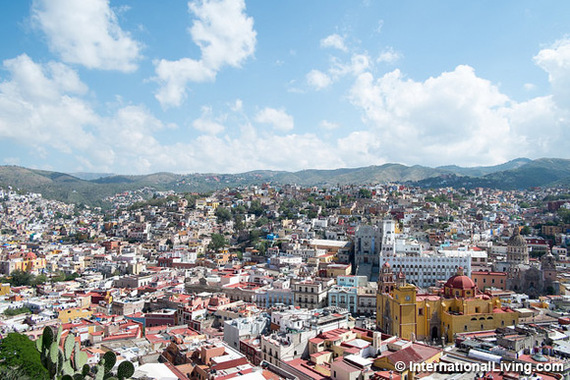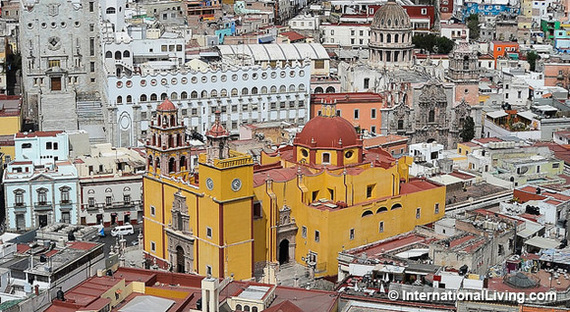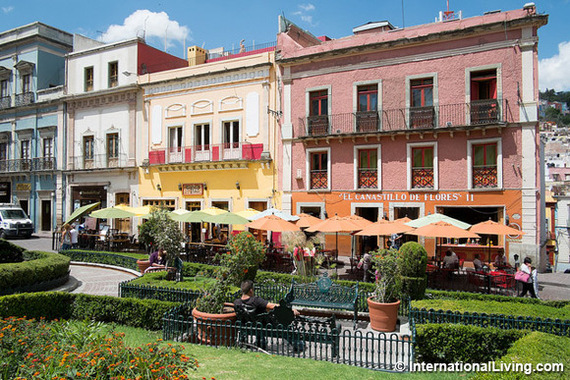If you're a fan of the arts ... especially the performing arts ... there's no place better than Guanajuato. For that reason ... and for its sheer beauty, convenience, and near-perfect climate, Guanajuato makes our "where to retire in Mexico" list.
City View, Guanajuato, Mexico
You'll find it 50 miles west of another popular and better-known expat retirement enclave, San Miguel de Allende. Both are in the state of Guanajuato, and the city of the same name is the state capital. At an elevation of 6,600 feet, Guanajuato enjoys a mild climate, with temperatures rarely dipping below 60 F on a winter day or topping 90 F on a summer day.
If you've an open spot on your calendar in October, Guanajuato is the place to be. That's when the city hosts the International Cervantes Festival, one of the biggest and best-known performing-arts festivals in all of Latin America -- a two-week extravaganza that attracts top-flight performers in theater, dance, and music from around the world.
During the Cervantes Festival, these events are sometimes going on simultaneously in concert halls, churches, cathedrals, and event spaces throughout the city, including in the magnificent Teatro Juárez, right in the center of historic Guanajuato. A visit to the Juárez Theater should be on your "must-do" list. It's one of the most important performing-arts centers in Mexico.
Our Lady of Guanajuato Basilica, Guanajuato, Mexico
If you can't make it to Guanajuato in October, don't worry. This city lives and breathes music year-round. There are concerts almost every night somewhere or other. On weekends the city band plays and roving mariachi bands sing for café patrons in the Jardín de la Unión -- the Union Gardens -- and in the Plaza de la Paz.
At night, you'll often find the University of Guanajuato's roving band of troubadour singing away in 16th-century dress. This huge state university, which traces its history to 1732, is located right in the city center, and thousands of students live here much of the year. You'll see them in the restaurants and bars, attending concerts, strolling the streets, and lending the city its energy.
That's why expats who live in Guanajuato contrast it to San Miguel de Allende by saying that while the latter has better restaurants, Guanajuato has a more youthful vibe. That's over simplifying, of course. But it's true that each city has its own distinct personality.
For sure, Guanajuato has much to offer. For centuries it was one of the richest cities in Mexico. Gold and silver mines around Guanajuato produced a river of wealth from the 16th century onwards, and mining remains an important industry even today. The city's beautiful historic center, which trails up and down steep hills, has been a UNESCO World Heritage site since 1988. It's an extraordinarily beautiful city.
Guanajuato played a key role in Mexico's War of Independence from Spain. The first major victory of the war was won here, when Mexican forces captured the former grain storage building known as El Alhóndiga. Today, it's a museum with a large open-air performance space.
Plaza de la Paz, Guanajuato, Mexico
Near it is Hidalgo Market, Guanajuato's large central market. If you lived here, this is where you might do your grocery shopping, catch a quick meal, and buy any number of locally made ceramics or leather products.
Founded in 1548 (shortly after San Miguel de Allende) the oldest neighborhoods of Guanajuato date from the 16th and 17th centuries and its narrow streets were designed for horses and burros, not for SUVs. Many of these streets are actually very narrow stair-stepped passageways. Nothing on wheels can get up them.
Much of Guanajuato's historic center, in fact, is pedestrian only. To get around by car, the city has constructed a maze of incredible underground tunnels, complete with road signs.
(On our first drive to Guanajuato, we were lost in this maze for three hours, popping up now and then to get our bearings and then heading back underground to try to locate the proper exit. Take it from us, driving here is not for the faint hearted.)
The best advice if you're looking to live in the historic center is to be sure to check street access if you want to have a car. Otherwise, get used to toting groceries and supplies up those steep hills or hiring a delivery service.
While you may want a car, you don't really need a car in Guanajuato ... taxis are plentiful and think of the workout you'll get hiking up and down those hills. And of course, as you'd imagine in a city of this size, with more than 150,000 inhabitants in the municipality, you'll find all the modern malls, supermarkets and hospitals and healthcare facilities you'd expect -- most in neighborhoods just outside the central historic district.
For a target cost of living, a couple could easily live on a budget of $2,000 a month in Guanajuato, including rent -- especially with today's strong dollar and weak peso. At time of writing the exchange rate hovers close to 1 USD:18 MXN. See current rates here.
You can find a comfortably furnished rental starting at about $700 a month. You won't need heat or air conditioning so your utility costs will be low. Shop at the local mercado for fresh, locally grown fruits and vegetables and your grocery bill will be low, too.
If you'd like to buy a home, you'll find prices more reasonable in Guanajuato than in the more-popular-with-expats San Miguel de Allende. (Note that the international airport at Léon is just 20 minutes from Guanajuato.)
On a recent visit, we found a property in the San Isidro neighborhood of Guanajuato's central historic district (known as centro), with two 1,000-square-foot apartments. On the lower level is an open-plan apartment with dining room, living room, bedroom, and bathroom. The upper-level apartment offers two bedrooms, a large bathroom, a study, and a small terrace. The two apartments share a large back garden. Completely furnished, the price is just $240,000.
If you look beyond centro, there are several neighborhoods where the terrain is relatively flat and you might easily have a car. Two that are particularly popular with expats are Marfil and La Presa.
In Marfil, one of Guanajuato's oldest and most historical neighborhoods, homes tend to be Spanish-colonial style and are large and gracious. They often have ample garden spaces.
La Presa takes its name from the reservoir at its center where you'll often see people rowing boats or picnicking around the shore. Streets here are wide, and many of the homes are large, 19th-century style.
One thing to note: Guanajuato's expat community is much smaller than San Miguel's...perhaps 1,000 expats live here, as compared to San Miguel's 10,000 or so ... and fewer locals in Guanajuato speak English. Instead, it's very much a Spanish-speaking city, and if you live here long-term you'll want to learn Spanish, which makes day-to-day life much easier.
Appearance-wise, this corner of the world feels a bit lost in time ... yet every modern amenity is here. The cultural appeal can't be beat. And neither can the climate or the cost of living ...
That's why we're high on this part of Mexico -- and if you're looking for an amazing quality of life at an affordable price tag, you should be, too.
Related Articles
Having Fun Is a Full-Time "Job" In Mexico
Exploring the Charms of San Miguel De Allende
What's My Favorite Retirement Haven? I Don't Know Yet...
Earlier on Huff/Post50:
